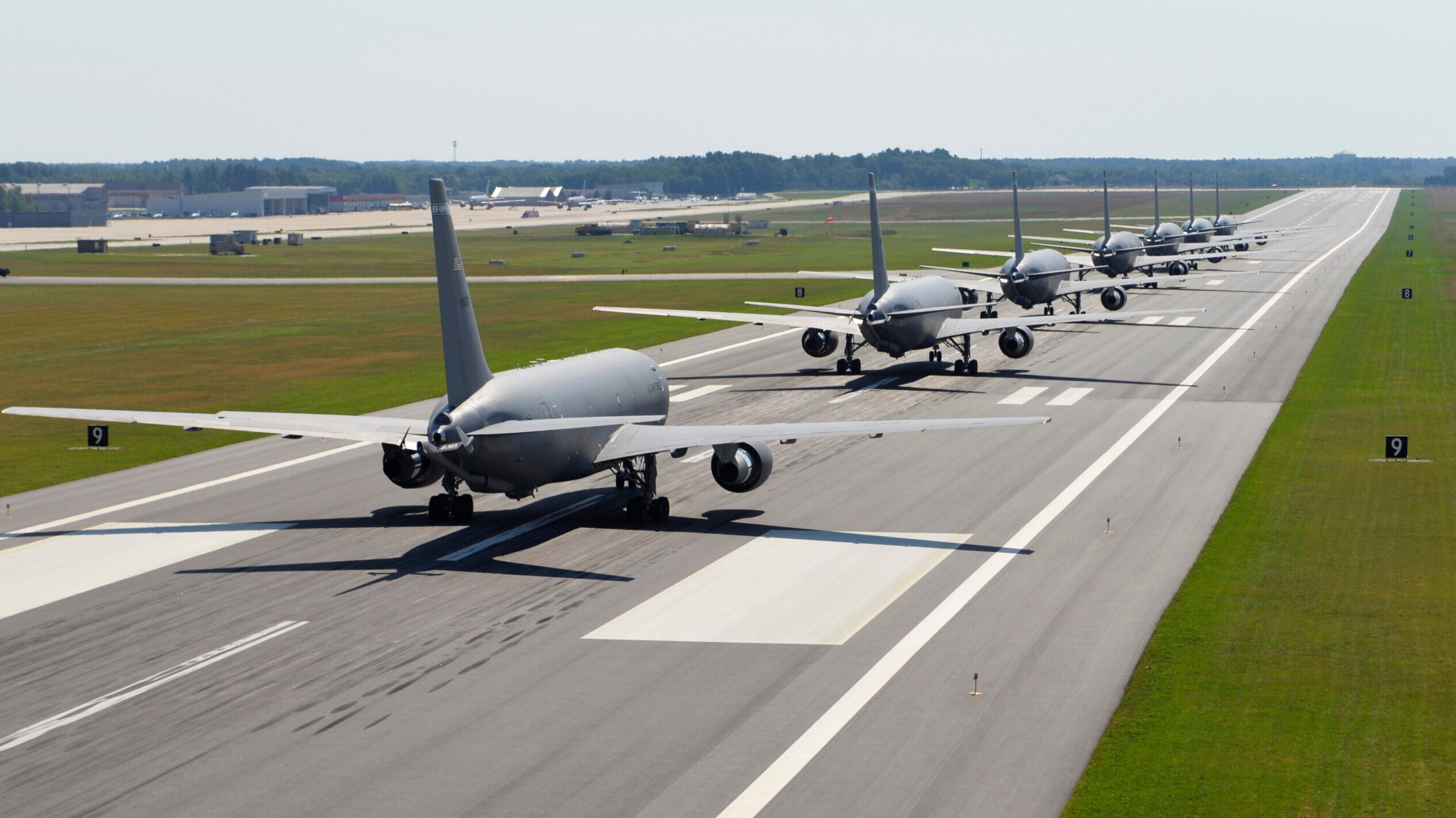
KC-46A aircraft assigned to the 157th Air Refueling Wing perform an elephant walk formation on the runway at Pease Air National Guard Base, Sept. 8, 2021. (U.S. Air National Guard Photo by Senior Master Sgt. Timm Huffman)
AFA 2023 — As the Air Force forges ahead with plans to procure a new batch of tankers, officials are trying to avoid shiny promises from industry and instead get at the absolute truth about what America’s industrial base can deliver, the service’s top weapons buyer tells Breaking Defense.
“We just kind of need to get their no-kidding ground truth of, ‘this is what we think we can deliver and when we think we can deliver it,'” Andrew Hunter, the service’s acquisition chief, said in a Sept. 5 interview at the Pentagon.
In the spring, Hunter disclosed that the service is leaning toward procuring 75 more of Boeing’s KC-46A Pegasus tankers in lieu of a competitive effort that would see a bid from Lockheed Martin’s LMXT. Since then, a top Air Force official emphasized that the service still isn’t sure on its acquisition strategy, something Hunter said reflects the procurement process working.
“Mechanically, what has happened is we’ve gotten farther along in the requirements process,” Hunter said, which features input from the joint staff and settling on a more concrete idea about what’s being asked of industry.
“I’ve characterized it [the tanker procurement] as, it is very much in line with the KC-X requirement, which ultimately the KC-46 was selected to fulfill,” he said. The new tanker requirement, as Hunter has previously explained, entails more “modest changes,” like certain communications improvements.
For years, the Air Force planned to follow the KC-46A with KC-Y and KC-Z contests, which on paper would have involved new offerings from industry for each phase. But as time went on, Air Force officials started to hint that a KC-Y competition was looking less likely.
In March, Hunter revealed that both KC-Y and KC-Z were no more, and that officials would in the near term pursue a more limited tranche of tanker procurement to get to a next-gen air refueler in the 2030s. A critical factor in the service’s decision, Hunter said, was the timeline for delivery, which he reiterated would be a key element of the service’s assessment for its upcoming tanker buy.
That currently is down to either more KC-46s, or potentially the Lockheed-Airbus teamup of a converted A330 MRTT branded as the LMXT. However, Lockheed will need to stand up an industrial base to support the effort, which company officials have said will require a minimum but unspecified amount of tanker production to make their business case viable.
RELATED: From cargo to cockpit: A KC-46A crew’s thoughts about the plane’s potential tanker rival
Hunter heeded those comments, noting that “one of the concerns has been the number of how many aircraft because there is some in industry who are looking at possibly establishing new production lines, and so the number of aircraft is important to them.”
After the Air Force recently released a notice to industry that a request for information (RFI) for the tanker program would be posted this month, Hunter said “what we gave them in the RFI essentially was a range. So the desire being we really want to understand, like, where’s the break point, and what can they do and what can’t they do?
“We’ve kind of heard some feedback on that informally, but obviously an RFI is a little more formal,” he added.
But asked whether he still anticipated that Boeing’s Pegasus may be the answer for the Air Force’s tanker plans, Hunter sounded more noncommittal than he did to start the year.
“To me, it’s all going to be dependent on what we get back in the RFI, and what they can actually deliver,” he said.
Looking ahead to the Air Force’s futuristic tanker, known as the Next-Generation Air Refueling System (NGAS), Hunter warned that a looming continuing resolution (CR) could adversely impact the service’s near-term plans to move analysis work on the next-gen tanker forward.
Negotiations With Boeing
Last year, Hunter said that the Air Force had “struggled” to reach certain agreements with Boeing. In the year since, “we’ve definitely made some progress,” he said, though “it’s still a challenge.”
The acquisition czar explained that Boeing was having difficulty submitting proposals in a timely fashion with all the information officials needed — hampering their ability to even begin negotiations on factors like cost.
“It’s very frustrating, I think, to all of us, if we just sit around waiting for a proposal to get to the point where we get to argue about pricing,” he said. “In some cases that’s been many months, to even as long as a year or more.”
Problems with proposals aren’t “unique to Boeing,” Hunter added, but the company’s size is the issue: as one of the Air Force’s largest contractors, “the volume of proposals… stands out,” he said.
The plane builder has taken steps to improve its performance, Hunter said, such as by making internal investments and “staffing up and improving their ability to put together compliant proposals and do so in a much more timely way.” Boeing declined to comment.
“They are endeavoring to meet that goal,” Hunter said. “And I think it serves us both if we can do that.”























